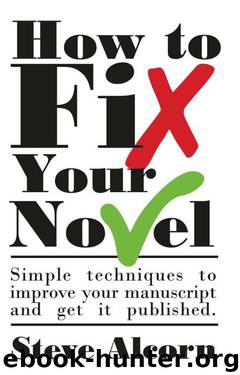How To Fix Your Novel by Steve Alcorn

Author:Steve Alcorn [Alcorn, Steve]
Language: eng
Format: epub
Publisher: Theme Perks
Published: 2012-03-03T18:30:00+00:00
Suspense
123
Chapter 14
Suspense
When conflict creates not action, but the possibility of action, that’s suspense. Here’s an example:
When Mark told her he was leaving her, Valerie was so mad that she snatched up the keys to his beloved Corvette and stormed out of the house.
What does she do next? Steal the car? Wreck it? Drop the keys down a storm drain? Nothing? We don’t know, and the uncertainty of the conflict’s outcome creates suspense. We’ll return to Mark and Valerie later . . .
See? I’m already creating suspense.
Okay, since both action and suspense arise from conflict, how do you decide which to use? Part of the choice depends on what type of story you’re writing.
An action adventure generally moves too fast for the dramatic pauses needed to create suspense. Sure, you can slow things down now and then to create suspense. (Think of Indiana Jones lifting the gold idol from the plinth at the beginning of Raiders of the Lost Ark. We know something bad is going to happen, but we don’t know what or how fast.) But for the most part, your story needs to remain fast-paced to keep your readers’ attention.
On the other hand, if you’re writing a thriller or a mystery, you may have relatively little action but lots of conflict. Even slasher movies have only so many victims—these films spend most of their time building suspense.
Most dramas and love stories rely more on suspense than action too. Will he or won’t he? Will they get together or split forever? What will happen if she does this?
Nearly all stories are better with some suspense, even if it lasts for only a single paragraph. Here’s an example:
Tom and Dave had never liked each other, but their mutual hatred hit a new high when Tom asked Dave’s girlfriend, Sue, to the senior prom and she accepted. Dave took another girl, but soon after arriving, he abandoned her and just stood at the edge of the dance floor, glaring at Tom and Sue as they danced. When the band started playing the song that Dave and Sue had promised would always be “their song,” it was more than Dave could take. He . . .
What? What did he do?
We can’t tell. Did he storm out of the dance? Snatch Sue away from Tom? Or punch Tom out? The outcome is uncertain and therefore suspenseful.
Tom taking Sue to the dance would simply be activity. But Tom taking Dave’s girlfriend to the dance is conflict. Dave abandoning his date is conflict. And Dave glaring at Tom and Sue is also conflict. The conflict leads to suspense and may lead to action.
Here’s the same scenario without the suspense:
Tom and Dave had never liked each other, but their mutual hatred hit a new high when Tom took Dave’s girlfriend, Sue, to the senior prom. Dave stormed onto the dance floor and grabbed Sue away from Tom, who responded with a punch so hard it sent Dave sprawling into the bleachers.
No suspense this time, just conflict, immediately followed by action.
Download
This site does not store any files on its server. We only index and link to content provided by other sites. Please contact the content providers to delete copyright contents if any and email us, we'll remove relevant links or contents immediately.
Asking the Right Questions: A Guide to Critical Thinking by M. Neil Browne & Stuart M. Keeley(5649)
Autoboyography by Christina Lauren(5184)
Eat That Frog! by Brian Tracy(4436)
Dialogue by Robert McKee(4323)
Sticky Fingers by Joe Hagan(4103)
Journeys Out of the Body by Robert Monroe(3572)
Annapurna by Maurice Herzog(3424)
Full Circle by Michael Palin(3389)
Schaum's Quick Guide to Writing Great Short Stories by Margaret Lucke(3321)
Elements of Style 2017 by Richard De A'Morelli(3307)
The Art of Dramatic Writing: Its Basis in the Creative Interpretation of Human Motives by Egri Lajos(3017)
Atlas Obscura by Joshua Foer(2900)
The Diviners by Libba Bray(2887)
Why I Write by George Orwell(2877)
In Patagonia by Bruce Chatwin(2876)
The Fight by Norman Mailer(2848)
The Mental Game of Writing: How to Overcome Obstacles, Stay Creative and Productive, and Free Your Mind for Success by James Scott Bell(2845)
Venice by Jan Morris(2526)
The Elements of Style by William Strunk and E. B. White(2442)
